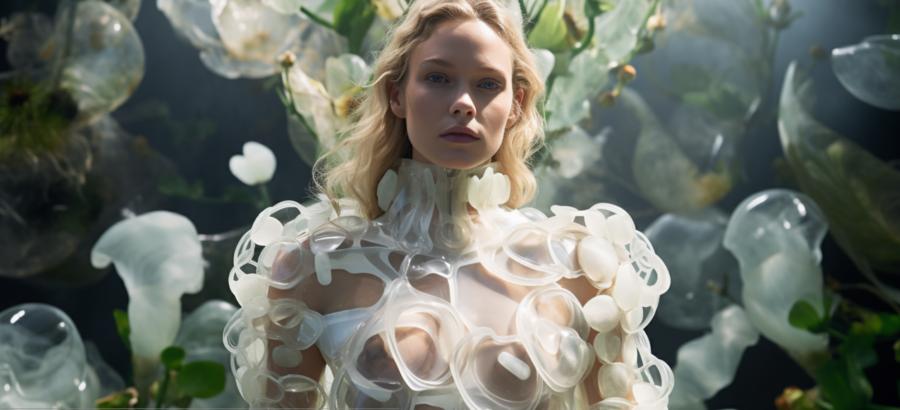Biofabrication: Next Frontier in Sustainable Fashion?

Introduction: A Fashion Emergency
Picture this: you're strolling down the high street, ready to indulge in some retail therapy, when you spot a snazzy pair of shoes in a store window. But wait! Before you whip out your wallet, have you considered the environmental impact of that fabulous footwear? Did you know that the fashion industry is a leading contributor to pollution, waste, and general planetary desecration? It's enough to make your head spin faster than a runway model on a caffeine bender.But fear not, fashion-conscious friends! A new movement is afoot (pun intended) to change the way we clothe ourselves, and it's called biofabrication. This cutting-edge technology involves the production of materials such as leather, silk, and even fur, using living organisms like bacteria, fungi, and algae. So, before you swear off shopping altogether in a fit of eco-guilt, let's take a closer look at this brave new world of sustainable style.
Leather: Bye-Bye, Bovine
The production of traditional leather is a resource-intensive, environmentally-destructive process that frequently involves the use of toxic chemicals. Enter lab-grown leather: a material made using a process called "cellular agriculture," in which cells are cultured in a lab and assembled into a hide-like material. Not only does this eliminate the need for animal slaughter, but it also uses significantly less water and emissions compared to traditional leather production.Companies such as Modern Meadow and VitroLabs are leading the charge in this space, refining the methods and tinkering with the design possibilities. Imagine a world where your leather jacket, shoes, or handbag are not only cruelty-free but also customizable, with endless options for texture, color, and pattern. The future is now, my fashion-forward friends, and it's looking rather...vegan.
Silk: The Web of Life
Picture a spider's web: intricate, delicate, and astoundingly strong. Now imagine if we could harness that same material and weave it into a silky-smooth fabric. Thanks to biofabrication, that dream is becoming a reality. Companies like Bolt Threads and Spiber are developing synthetic silk proteins, inspired by the molecular structure of spider silk, to create a new generation of fabrics.This process, called "microbial fermentation," involves genetically engineering microorganisms (e.g., yeast, bacteria, or fungi) to produce silk proteins, which are then spun into fibers and woven into textiles. The result is a material that is not only more sustainable and animal-friendly than traditional silk (which involves boiling silkworms alive), but also potentially stronger, lighter, and more versatile. Spider-Man would be proud.
Fur: Fungi for the Win
For those who crave the luxurious feel of fur without the attached guilt and ecological destruction, behold: mycelium-based fur. Mycelium is the root-like structure of fungi and can be grown into various shapes and textures, including one that closely resembles animal fur. Companies such as MycoWorks and Ecovative Design are exploring the potential of this fungal wonder for fashion applications.Mycelium fur offers a sustainable, cruelty-free alternative to animal-derived fur, with the added bonus of requiring less water, energy, and chemicals to produce. Plus, since it's naturally biodegradable, you won't have to worry about your furry fashion statement lingering in a landfill for all eternity. Just make sure to store it properly, lest you end up with a sentient fungal coat that seeks vengeance on its wearer...or, you know, just gets moldy.
Algae: It's Not Just for Sushi Anymore
Finally, let us dive into the aquatic world of algae, those slimy, greenish-brown floaters that may soon revolutionize the fashion industry. Algae can be processed into a variety of materials, including biofabricated textiles and dyes.For instance, AlgiKnit is a company that creates yarn derived from kelp, a type of seaweed. The resulting fiber is not only biodegradable and renewable, but also boasts impressive strength and flexibility. Meanwhile, Living Ink has developed a method to create sustainable, algae-based ink for screen printing and other applications. Who knew that pond scum could be so fashionable?
Conclusion: A Sustainable Style Revolution
As we teeter on the precipice of ecological disaster, it's high time for the fashion industry to clean up its act. Biofabrication offers a glimmer of hope in this seemingly apocalyptic scenario, providing us with innovative materials that are kinder to the planet and its inhabitants. So, the next time you're out shopping for that perfect outfit, consider seeking out brands that embrace the biofabricated future. After all, there's nothing more stylish than saving the world.Article kindly provided by foreverinfashion.org
Latest Articles
- Staying Trendy: How Beauty Salons Can Capitalize on Fashion Trend
- Grill and Chill: Fashion Ideas for the Ultimate Barbecue Bash
- Enhancing Your Well-being and Style: The Benefits of High-Quality Italian Handbags
- Miami's Sporting Giants Forge Fashion Frontiers
- Glazed and Confused: The Porcelain Paradox in Kitchens and Couture
- Glowing Skin as Your Ultimate Fashion Statement
- Fashion Feasts: Stylish Ventures in Healthy Eating
- Wardrobe Revolution: Embracing the Green Thread of Sustainable Clothing
- Fusing Fashion with Fitness: A Start-Up for the Style-Conscious and Health-Minded
- The Sartorial Rider: An Ode to the Motorcycle Clothing Connoisseur
- Fashion History and Current Trends in Hong Kong
- Delving into the Fashion History and Current Trends of Lisbon
- Fashion in Milan: A Walk Through Time and Style
- The Fashionable Past and Present of Sao Paulo, Brazil
- Accessories
- Jewellery
- Footwear
- Skirts and Dresses
- Shirts and Blouses
- Beauty and Makeup
- Fashion Photography
- Sustainable Fashion
- Street Style
- Fashion History
- Fashion Business
- Fashion Styling
- Fashion Events
- Plus-Size Fashion
- Men's Fashion
- Women's Fashion
- Fashion Blogging
- Fashion Trends
- Fashion Retailers
- Fashion Tips and Advice
- Fashion Business Startups
- Fashion Around the World
- Lingerie
- Sportswear
- Weddings

